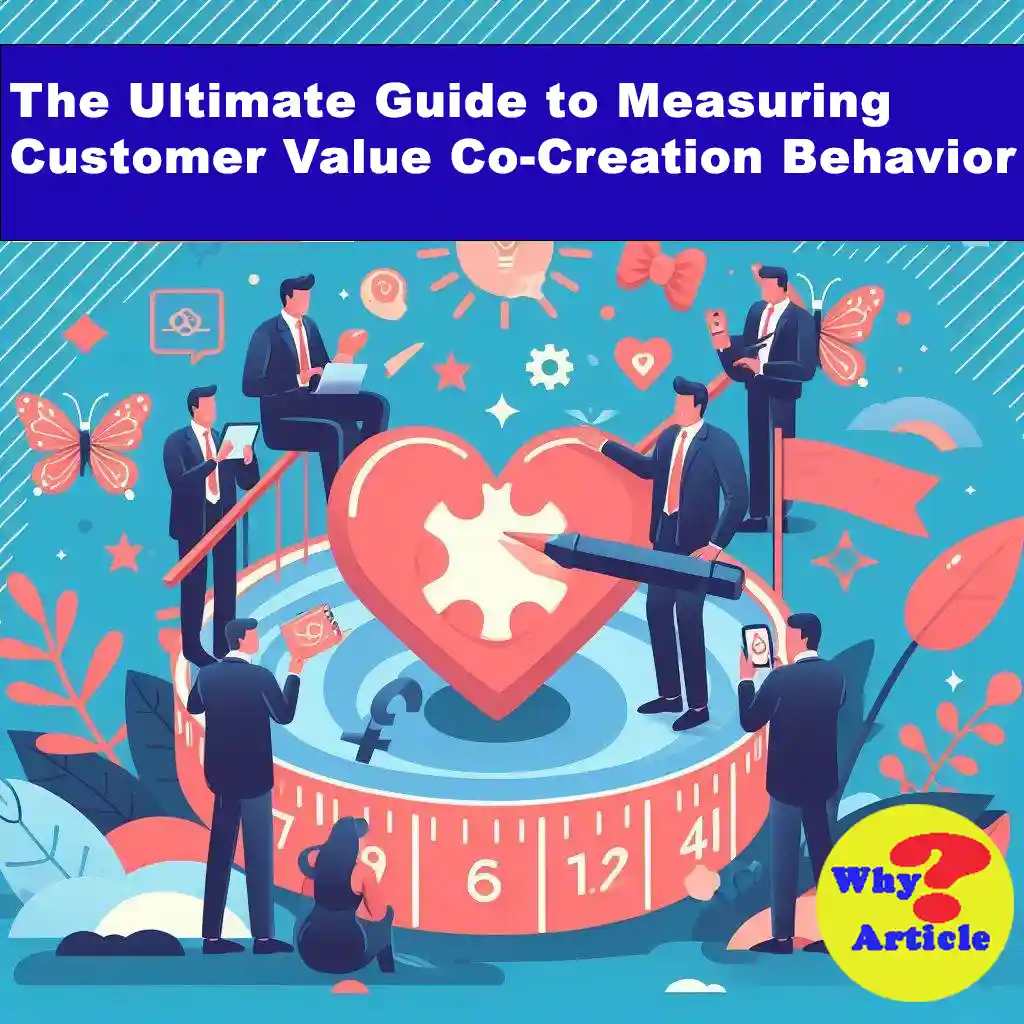The Ultimate Guide to Measuring Customer Value Co-Creation Behavior
In today’s competitive business landscape, the way companies interact with customers has evolved dramatically. Customers are no longer passive recipients of products and services; they have become active participants in creating value. This shift towards customer value co-creation has become a critical factor for businesses aiming to achieve a competitive edge.
But how can we measure this behavior? Understanding and measuring customer value co-creation is essential for businesses to enhance customer satisfaction, loyalty, and overall performance.
This comprehensive guide delves into the concept of customer value co-creation, explores the methodologies to measure it, and discusses the implications for businesses.
Whether you are a marketer, a business strategist, or simply interested in customer behavior, this guide provides valuable insights into the dynamic world of customer engagement and co-creation.
Understanding Customer Value Co-Creation
1. The Concept of Value Co-Creation
Value co-creation is a collaborative process where customers actively participate in creating value through interactions with businesses.
This paradigm shift is rooted in the Service-Dominant Logic (SDL), which posits that value is not delivered by firms but created through customer experiences and interactions.
Unlike the traditional view where companies produce and customers consume, value co-creation emphasizes mutual contribution to value generation.
2. The Role of Customers in Co-Creation
Customers today are more informed and empowered than ever before. With access to vast amounts of information, they seek active involvement in the design and delivery of products and services.
This involvement can range from providing feedback and suggestions to directly influencing product development and service customization. By engaging in co-creation, customers feel valued and become more loyal to the brand.
Measuring Customer Value Co-Creation Behavior
1. Yi and Gong’s Scale for Measuring Co-Creation Behavior
To measure customer value co-creation, Yi and Gong (2013) developed a multidimensional scale.
This scale assesses two primary dimensions: participative behavior and citizenship behavior.
Each dimension encompasses several factors that collectively capture the essence of co-creation.
2. Dimensions of Co-Creation Behavior
Participative Behavior
This dimension involves direct customer engagement during service provision. It includes:
Information Seeking
Customers gather necessary information to effectively engage in co-creation.
Information Sharing
Customers communicate their needs and preferences to the service provider.
Responsible Behavior
Customers follow guidelines and collaborate with service providers.
Personal Interaction
Customers build rapport with service providers through courteous and respectful interactions.
Citizenship Behavior
This dimension reflects voluntary actions that enhance the overall service experience but are not essential for service provision. It includes:
Feedback
Customers provide constructive feedback to improve services.
Advocacy
Customers recommend the service to others.
Helping
Customers assist other customers in understanding and using the service.
Tolerance
Customers exhibit patience and understanding when service expectations are not met.
3. Applying the Measurement Scale
To validate Yi and Gong’s scale, researchers conducted empirical studies across various contexts.
For instance, a study among personal care center users in the Southern Cone tested the scale’s applicability. The process involved translating and adapting the scale to the local context, ensuring linguistic and cultural relevance. The scale’s reliability and validity were rigorously tested through statistical analyses, confirming its robustness in measuring co-creation behavior.
Implications of Measuring Co-Creation Behavior
1. Enhancing Customer Satisfaction and Loyalty
Understanding and measuring co-creation behavior helps businesses tailor their strategies to better meet customer needs.
By recognizing the active role of customers in value creation, companies can design more personalized and engaging experiences.
This not only enhances customer satisfaction but also fosters loyalty and long-term relationships.
2. Strategic Insights for Business Improvement
Accurate measurement of co-creation behavior provides valuable insights into customer preferences and behaviors. These insights can guide businesses in refining their offerings, improving service quality, and developing innovative solutions.
For instance, feedback and advocacy behaviors indicate areas of strength and potential improvement, allowing businesses to make informed strategic decisions.
3. Competitive Advantage
In a highly competitive market, businesses that effectively engage customers in co-creation gain a significant advantage.
Co-creation fosters a sense of ownership and connection among customers, differentiating the brand from competitors.
By leveraging the power of customer engagement, companies can achieve sustained competitive advantage and drive business growth.
Methodological Considerations in Co-Creation Research
1. Ensuring Measurement Validity and Reliability
To ensure the accuracy of co-creation behavior measurements, it is crucial to validate the scale in different contexts. This involves translating and adapting the scale to various languages and cultures, as well as conducting pilot tests to refine the measurement items.
Statistical analyses such as exploratory factor analysis (EFA) and confirmatory factor analysis (CFA) are essential to establish the scale’s validity and reliability.
2. Challenges and Limitations
Despite the robustness of Yi and Gong’s scale, there are challenges in measuring co-creation behavior.
For instance, cultural differences may influence how customers perceive and engage in co-creation activities.
Additionally, the scale may need to be periodically updated to reflect evolving customer behaviors and technological advancements.
3. Future Research Directions
Future research should explore the application of the co-creation measurement scale in diverse industries and cultural settings.
Longitudinal studies can provide deeper insights into how co-creation behaviors evolve over time and their long-term impact on business performance.
Additionally, investigating the antecedents and consequences of co-creation behavior can enhance our understanding of the factors driving customer engagement.
Practical Applications for Businesses
1. Designing Co-Creation Strategies
Businesses can use the insights from co-creation behavior measurements to design effective co-creation strategies. This includes creating platforms for customer feedback, developing loyalty programs that reward co-creation behaviors, and fostering a culture of collaboration and transparency.
By actively involving customers in the value creation process, businesses can enhance their offerings and strengthen customer relationships.
2. Training and Empowering Employees
Employees play a crucial role in facilitating co-creation. Training programs that emphasize the importance of customer engagement and equip employees with the skills to foster co-creation are essential.
Empowering employees to act on customer feedback and suggestions can significantly improve service quality and customer satisfaction.
3. Leveraging Technology
Technology can greatly enhance the co-creation experience. Businesses can leverage digital platforms, social media, and mobile applications to facilitate real-time customer interactions and feedback.
Implementing advanced analytics can help businesses track co-creation behaviors and identify trends, enabling more targeted and effective co-creation initiatives.
Conclusion
Measuring customer value co-creation behavior is a vital step for businesses seeking to thrive in a competitive market. By understanding and leveraging the active role of customers in value creation, companies can enhance customer satisfaction, loyalty, and overall performance.
Yi and Gong’s scale provides a robust framework for assessing co-creation behaviors, offering valuable insights for strategic decision-making.
As businesses continue to navigate the complexities of customer engagement, the ability to measure and understand co-creation behavior will become increasingly important.
By adopting a customer-centric approach and fostering a culture of collaboration, businesses can create meaningful and lasting value for both customers and the organization.
Customer value co-creation is a collaborative process where customers actively participate in creating value through interactions with businesses. It involves customers engaging in activities such as providing feedback, sharing information, and collaborating with service providers.
Businesses can measure co-creation behavior using scales like Yi and Gong’s, which assess dimensions such as participative behavior and citizenship behavior. This involves collecting data through surveys and analyzing it to evaluate customer engagement in value creation.
Measuring co-creation behavior is important because it helps businesses understand customer engagement, tailor their strategies to meet customer needs, and enhance customer satisfaction and loyalty. It also provides insights for improving service quality and achieving a competitive advantage.
Co-creation behavior includes dimensions such as information seeking, information sharing, responsible behavior, personal interaction, feedback, advocacy, helping, and tolerance. These dimensions capture different aspects of how customers engage in value creation.
Businesses can encourage co-creation behavior by creating platforms for customer feedback, rewarding co-creation behaviors, fostering a culture of collaboration, and leveraging technology to facilitate real-time customer interactions and feedback. Training and empowering employees to engage customers in co-creation activities is also essential.







